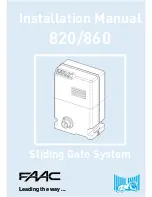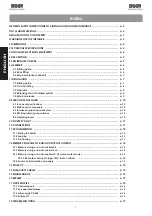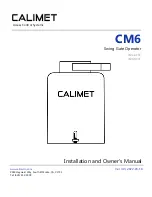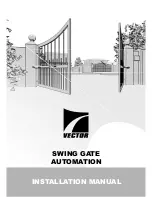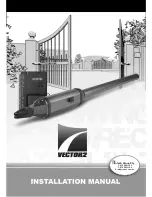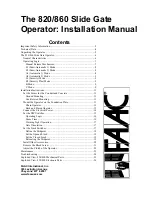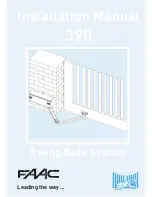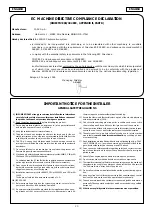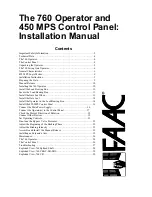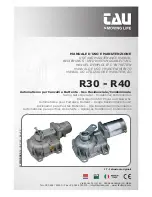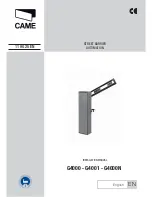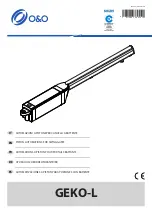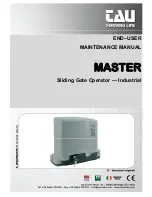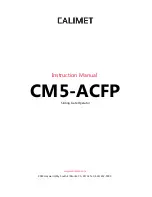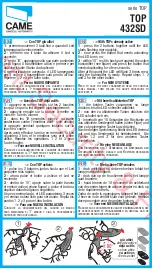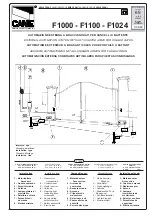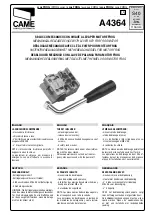
12
23
USER’S GUIDE
820 - 860 AUTOMATION
Read the instructions carefully before using the product
and keep them for future reference.
GENERAL SAFETY INSTRUCTIONS
If correctly installed and operated, the 820-860 automations
ensure a high level of safety.
However, some simple rules should be followed to avoid
accidents:
- Do not stand in the vicinity of the automation or allow
anyone else, especially children, to do so and do not
place objects in the vicinity of the automation. This is
particularly important during operation.
- Keep remote controls or any other control device out of
the reach of children to prevent them from accidentally
operating the automation.
- Do not allow children to play with the automation.
- Do not deliberately obstruct the movement of the gate.
- Make sure that branches or bushes do not interfere with
the movement of the gate.
- Keep the luminous signalling systems efficient and clearly
visible.
- Do not attempt to operate the gate manually without
first releasing it.
- In the event of a malfunction, release the gate to allow
access and call a qualified technician for service.
- After setting manual operation, disconnect the electricity
supply from the system before returning to normal
operation.
- Do not make any modifications to components belonging
to the automation system.
- Do not attempt to perform any repair work or tamper with
the automation. Call FAAC qualified personnel for repairs.
- At least once every six months have the automation, the
safety devices and the earth connection checked by a
qualified technician.
DESCRIPTION
The FAAC 820 - 860 automations are ideal for controlling
vehicle access areas with medium-high transit frequencies.
The 820 and 860 for sliding gates are electromechanical
operators which transmit movement to the leaf by means
of a pinion with rack or chain coupled in an appropriate
manner to the sliding gate.
If automatic operation has been selected, sending an
impulse causes the gate to reclose on its own after the
selected pause time.
If semiautomatic operation has been selected, a second
impulse must be sent to reclose the gate.
An opening impulse send while the gate is reclosing
causes it to change direction of movement.
A stop command (if available) stops movement at any time.
For detailed information on operation of the sliding gate
in the various operating modes, contact the installation
technician.
The automations have safety devices (photocells) which
prevent the gate from reclosing when an obstacle lies
within the area they are protecting.
The system ensures mechanical locking when the motor is
not in operation, so it is not necessary to install a lock.
For this reason the release system must be used for manual
opening.
The gear motors have mechanical/electronic clutches
which offer the necessary anti-crushing safety. An
electronic device allows the open/closed limit switch
positions to be programmed. The electronic control unit is
incorporated in the gear motors.
A convenient manual release device allows the gate to
be operated in the event of a power failure or malfunction.
The light flashes while the gate is moving.
MANUAL OPERATION
If the gate has to be operated manually due to a power
failure or malfunction of the automation, use the release
device as follows.
LEVER RELEASE DEVICE (Fig. 1)
- Remove the release device rubber cap.
- Insert the lever provided into the triangular slot release
system and turn
clockwise
by about 1/2 a revolution.
- Open or close the gate manually.
NUMBERED KEY RELEASE CAP (Fig. 2)
- Open the lock protection flap.
- Insert the key in the lock and turn.
- Turn the release cap
clockwise
.
- Open or close the gate manually.
RETURN TO NORMAL OPERATION
To prevent an accidental impulse from activating the
gate during the operation, turn off the electricity supply to
the system before relocking the operator.
LEVER RELEASE DEVICE (Fig. 1)
- Insert the lever provided into the triangular slot release
device and turn
anticlockwise
by about half a revolution.
- Refit the release device rubber cap.
- Move the gate until the release device engages.
NUMBERED KEY RELEASE CAP (Fig. 2).
- Open the lock protection flap.
- Insert the key into the lock and turn.
- Turn the release cap
anti-clockwise
.
- Move the gate until the release device engages.
1
2
Fig. 2
Fig. 1

